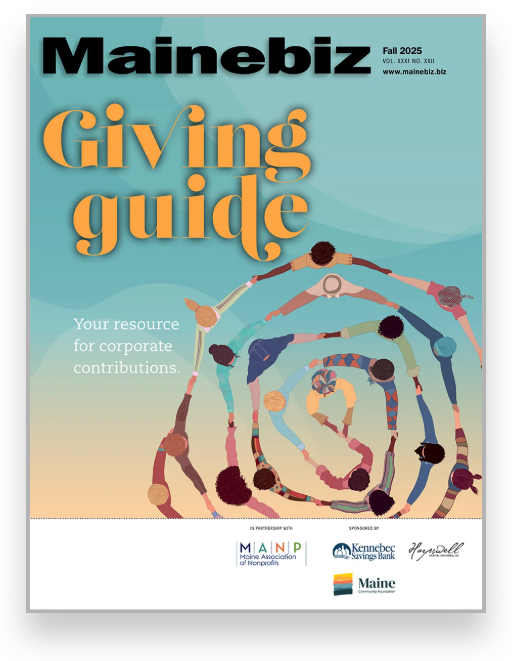Processing Your Payment
Please do not leave this page until complete. This can take a few moments.
- News
-
Editions
View Digital Editions
Biweekly Issues
- October 20, 2025
- October 6, 2025
- September 22, 2025
- September 8, 2025
- August 25, 2025
- August 11, 2025
- + More
Special Editions
- Lists
- Viewpoints
- Our Events
- Calendar
- Biz Marketplace
Bottoms up | Growing momentum for cluster development starts with the private sector
In late August, I joined about 50 other Mainers invited to hear Assistant Secretary of Commerce for Economic Development John Fernandez speak at DiMillo’s restaurant in Portland. After mingling with the group assembled by Congresswoman Chellie Pingree, Fernandez provided an hour of EDA briefing followed by a Q&A session. The clear thrust of his talk and of the agency’s future is in the realm of supporting more regional cluster development initiatives, particularly in new/clean energy. An agency historically focused on facilities and traditional economic development tools of the government, EDA has clearly bought into the broad, cross-agency focus on regional cluster development.
This should come as no surprise to any of you who have read my prior columns on the federal government’s unprecedented coordinated cluster push. As noted in earlier articles, a slew of cluster and innovation ecosystem solicitations were announced between February and July this year, led by the Department of Energy, the Economic Development Administration (part of the Department of Commerce) and/or the Small Business Administration. Beginning in August, announcements began to emerge for the first awardees of the most comprehensive and aligned economic development strategy and program in decades.
Money matters
The first and largest of these, the $129 million Energy Efficiency Regional Innovation Consortia was announced in February with DOE leading and the SBA, USDA and EDA supporting a single award to be provided to a university-based consortia that will serve as the first, federally funded energy-efficiency cluster development initiative. On Aug. 24, DOE announced that a consortium led by Penn State University won that nationally competitive bid (see www.energy.gov/news/9380.htm.)
Interestingly, the Center for American Progress will convene an EERIC “losers” conference on Oct. 4 and 5 seeking to see what lessons might be learned, convene players to collaborate on how to maintain and grow bottom-up cluster/innovation initiatives and to create a vibrant national network of these cluster organizers.
With fewer than 30 attending (including a couple non-EERIC cluster types, such as me), the event will also bring federal agency representatives from DOE, EDA and SBA to join the conversation to both hear feedback and encourage continued clustering.
On Sept. 15, the Department of Energy announced winners of an RFP to develop “innovation ecosystems” that will accelerate the movement of cutting-edge energy efficiency and renewable energy technologies from university laboratories into the market. DOE has not previously funded this type of award to a university. Five consortia — including one based in Cambridge, Mass. — won $1.05 million three-year awards (see www.energy.gov/news/9500.htm).
The following day, SBA announced 10 winners for its regional innovation cluster and defense technology cluster awards. Seven of 137 applications won contracts from SBA for its regional cluster program; three of 37 defense technology cluster contracts were awarded concurrently. For the record, I partnered with two cluster applicants — the Mass High Tech Council for its New England Defense Technology Initiative and the New England Clean Energy Council for a clean energy cluster program — neither of which made the final cut.
EDA will announce its six i6 Challenge award winners by early October. The i6 award will provide up to $1 million of matching funds to each winning applicant’s consortium of diverse public and private sector players with a strategy and program to drive innovation commercialization in the research-to-startup continuum. As noted in my July 12 column, “All Together Now,” I led a regional consortium that included cluster market actors in five New England states that hopes to contend for one of the six spots — a long shot, I’ll warrant, given the few number of awardees.
As noted in my Aug. 9 “Catalyzing Clusters” column, fiscal year 2010 announcements came as a surprise both in terms of the availability of funds in a tight budget environment and the rush to announce and award ahead of mid-term elections. The 2011 budget, if approved, includes more than $350 million of regional innovation/cluster allocations from the EDA ($75 million), the Department of Agriculture ($135 million), the Department of Labor ($108 million), the National Science Foundation ($12 million) and the SBA ($11 million). The government is just getting started.
In an economy as precarious as this one, the government’s role as catalyst — whether through grants, tax incentives or other funding sources — is essential to help the private sector pick up its rightful role as the lead on economic growth. Historically, cluster development initiatives have been led by state government, an important player without a doubt; however, the buzz in D.C. is private-sector led, meaning that initiatives to organize and manage these regional innovation strategies and activities must be bottom up, rather than top down. This not only ensures potential for long-term commitment, in contrast to political term-limited initiatives, but also assures program structures designed for their users. As this administration recognizes, the public sector is a critical and necessary partner for regional innovation, but success is optimized when the private sector runs with the ball.
Michael Gurau is president of Clear Innovation Partners, a Maine-based cluster development organization. He can be reached at mgurau@clearinnovationpartners.com. Read more Venture Builder here.
Mainebiz web partners

The Giving Guide
The Giving Guide helps nonprofits have the opportunity to showcase and differentiate their organizations so that businesses better understand how they can contribute to a nonprofit’s mission and work.
Learn More
Work for ME
Work for ME is a workforce development tool to help Maine’s employers target Maine’s emerging workforce. Work for ME highlights each industry, its impact on Maine’s economy, the jobs available to entry-level workers, the training and education needed to get a career started.
Learn More
Groundbreaking Maine
Whether you’re a developer, financer, architect, or industry enthusiast, Groundbreaking Maine is crafted to be your go-to source for valuable insights in Maine’s real estate and construction community.
Learn more-
The Giving Guide
The Giving Guide helps nonprofits have the opportunity to showcase and differentiate their organizations so that businesses better understand how they can contribute to a nonprofit’s mission and work.
-
Work for ME
Work for ME is a workforce development tool to help Maine’s employers target Maine’s emerging workforce. Work for ME highlights each industry, its impact on Maine’s economy, the jobs available to entry-level workers, the training and education needed to get a career started.
-
Groundbreaking Maine
Whether you’re a developer, financer, architect, or industry enthusiast, Groundbreaking Maine is crafted to be your go-to source for valuable insights in Maine’s real estate and construction community.
ABOUT
NEW ENGLAND BUSINESS MEDIA SITES
No articles left
Get access now
In order to use this feature, we need some information from you. You can also login or register for a free account.
By clicking submit you are agreeing to our cookie usage and Privacy Policy
Already have an account? Login
Already have an account? Login
Want to create an account? Register
Get access now
In order to use this feature, we need some information from you. You can also login or register for a free account.
By clicking submit you are agreeing to our cookie usage and Privacy Policy
Already have an account? Login
Already have an account? Login
Want to create an account? Register







Comments